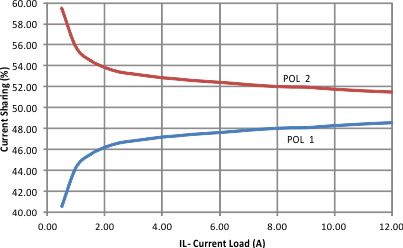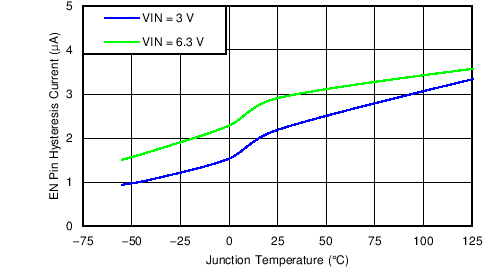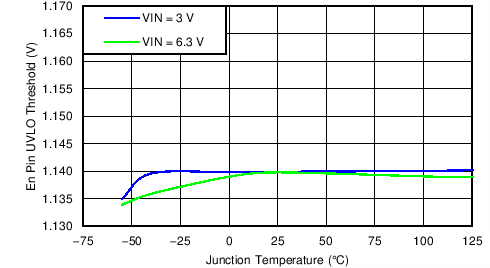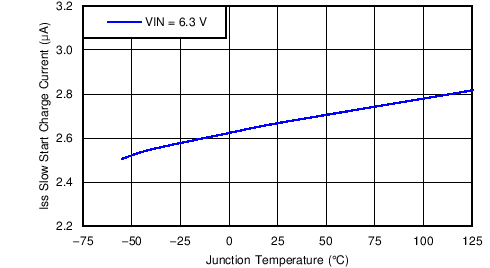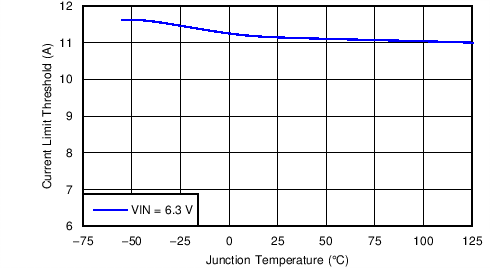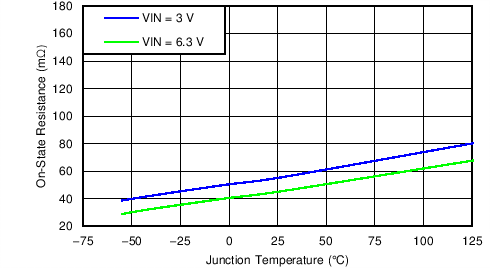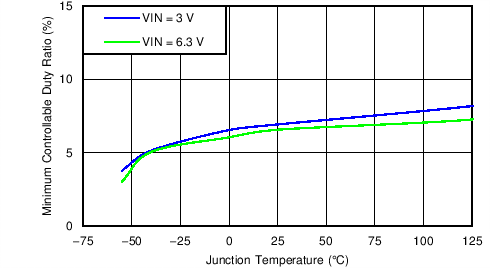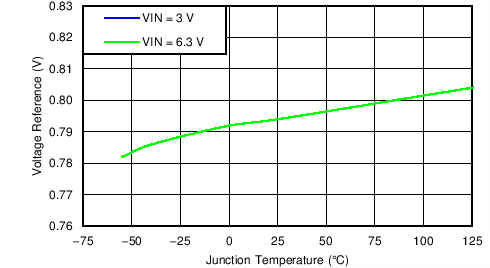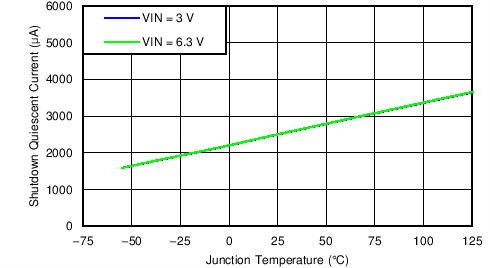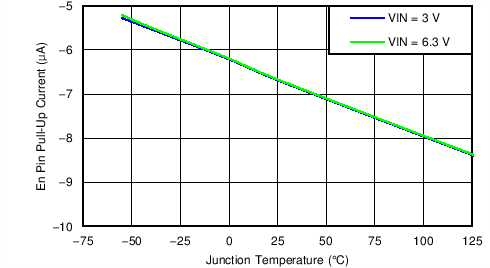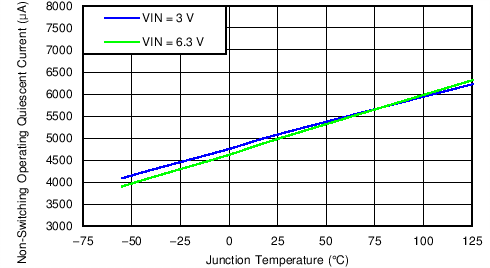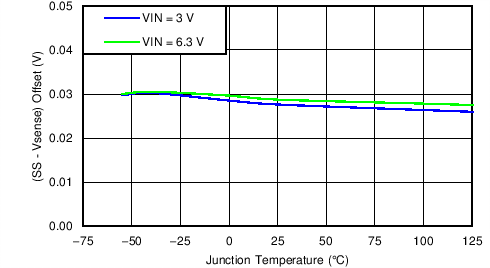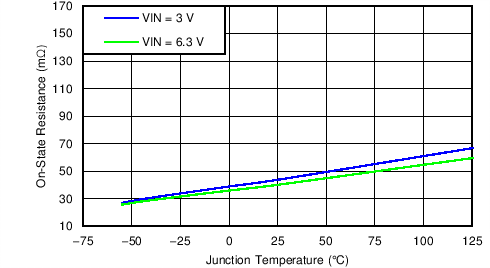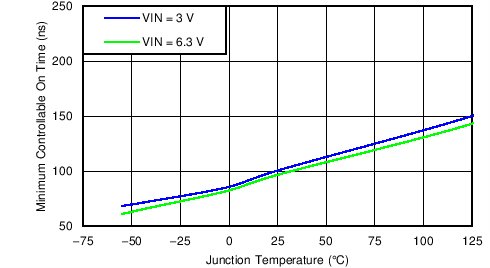SLVSD45 December 2015 TPS50601-SP
PRODUCTION DATA.
- 1 Features
- 2 Applications
- 3 Description
- 4 Revision History
- 5 Description (continued)
- 6 Pin Configuration and Functions
- 7 Specifications
-
8 Detailed Description
- 8.1 Overview
- 8.2 Functional Block Diagram
- 8.3
Feature Description
- 8.3.1 VIN and Power VIN Pins (VIN and PVIN)
- 8.3.2 PVIN vs Frequency
- 8.3.3 Voltage Reference
- 8.3.4 Adjusting the Output Voltage
- 8.3.5 Maximum Duty Cycle Limit
- 8.3.6 PVIN vs Frequency
- 8.3.7 Safe Start-Up into Prebiased Outputs
- 8.3.8 Error Amplifier
- 8.3.9 Slope Compensation
- 8.3.10 Enable and Adjust UVLO
- 8.3.11 Adjustable Switching Frequency and Synchronization (SYNC)
- 8.3.12 Slow Start (SS/TR)
- 8.3.13 Power Good (PWRGD)
- 8.3.14 Bootstrap Voltage (BOOT) and Low Dropout Operation
- 8.3.15 Sequencing (SS/TR)
- 8.3.16 Output Overvoltage Protection (OVP)
- 8.3.17 Overcurrent Protection
- 8.3.18 TPS50601-SP Thermal Shutdown
- 8.3.19 Turn-On Behavior
- 8.3.20 Small Signal Model for Loop Response
- 8.3.21 Simple Small Signal Model for Peak Current Mode Control
- 8.3.22 Small Signal Model for Frequency Compensation
- 8.4 Device Functional Modes
-
9 Application and Implementation
- 9.1 Application Information
- 9.2
Typical Application
- 9.2.1 Design Requirements
- 9.2.2
Detailed Design Procedure
- 9.2.2.1 Operating Frequency
- 9.2.2.2 Output Inductor Selection
- 9.2.2.3 Output Capacitor Selection
- 9.2.2.4 Input Capacitor Selection
- 9.2.2.5 Slow Start Capacitor Selection
- 9.2.2.6 Bootstrap Capacitor Selection
- 9.2.2.7 Undervoltage Lockout (UVLO) Set Point
- 9.2.2.8 Output Voltage Feedback Resistor Selection
- 9.2.2.9 Compensation Component Selection
- 9.2.3 Application Curve
- 10Power Supply Recommendations
- 11Layout
- 12Device and Documentation Support
- 13Mechanical, Packaging, and Orderable Information
Package Options
Mechanical Data (Package|Pins)
- HKH|20
- KGD|0
Thermal pad, mechanical data (Package|Pins)
Orderable Information
7 Specifications
7.1 Absolute Maximum Ratings
over operating temperature (unless otherwise noted)(1)| MIN | MAX | UNIT | ||
|---|---|---|---|---|
| Input voltage | VIN | –0.3 | 7 | V |
| PVIN | –0.3 | 7 | ||
| EN | –0.3 | 5.5 | ||
| BOOT | –0.3 | 14 | ||
| VSENSE | –0.3 | 3.3 | ||
| COMP | –0.3 | 3.3 | ||
| PWRGD | –0.3 | 5.5 | ||
| SS/TR | –0.3 | 5.5 | ||
| SYNC | –0.3 | 7 | ||
| Output voltage | BOOT-PH | 0 | 7 | V |
| PH | –1 | 7 | ||
| PH 10-ns transient | –3 | 7 | ||
| Vdiff | (GND to exposed thermal pad) | –0.2 | 0.2 | V |
| Output current | 6 | A | ||
| Source current | PH | Current limit | A | |
| RT | ±100 | µA | ||
| Sink current | PH | Current limit | A | |
| PVIN | Current limit | A | ||
| COMP | ±200 | µA | ||
| PWRGD | –0.1 | 5 | mA | |
| Operating junction temperature | –55 | 150 | °C | |
| Storage temperature, Tstg | –65 | 150 | °C | |
(1) Stresses beyond those listed under Absolute Maximum Ratings may cause permanent damage to the device. These are stress ratings only, which do not imply functional operation of the device at these or any other conditions beyond those indicated under Recommended Operating Conditions. Exposure to absolute-maximum-rated conditions for extended periods may affect device reliability.
7.2 ESD Ratings
| VALUE | UNIT | |||
|---|---|---|---|---|
| V(ESD) | Electrostatic discharge | Human body model (HBM), per ANSI/ESDA/JEDEC JS-001, all pins(1) | ±1000 | V |
| Charged device model (CDM), per JEDEC specification JESD22-C101, all pins(2) | ±1000 | |||
(1) JEDEC document JEP155 states that 500-V HBM allows safe manufacturing with a standard ESD control process.
(2) JEDEC document JEP157 states that 250-V CDM allows safe manufacturing with a standard ESD control process.
7.3 Recommended Operating Conditions
over operating free-air temperature range (unless otherwise noted)| MIN | NOM | MAX | UNIT | |||
|---|---|---|---|---|---|---|
| TJ | Junction operating temperature range | –55 | 125 | °C | ||
7.4 Thermal Information
| THERMAL METRIC(1) | TPS50601-SP | UNIT | |
|---|---|---|---|
| HKH (CFP) | |||
| 20 PINS | |||
| RθJC(bot) | Junction-to-case (bottom) thermal resistance | 0.514 | °C/W |
(1) Taken per Mil Standard 883 method 1012.1
7.5 Electrical Characteristics
TJ = –55°C to 125°C, VIN = 3 V to 6.3 V, PVIN = 1.6 V to 6.3 V (unless otherwise noted)| PARAMETER | TEST CONDITIONS | MIN | TYP | MAX | UNIT | |
|---|---|---|---|---|---|---|
| SUPPLY VOLTAGE (VIN AND PVIN PINS) | ||||||
| PVIN operating input voltage | 1.6 | 6.3 | V | |||
| VIN operating input voltage | 3 | 6.3 | V | |||
| VIN internal UVLO threshold | VIN rising | 2.75 | 3 | V | ||
| VIN internal UVLO hysteresis | 50 | mV | ||||
| VIN shutdown supply current | VEN = 0 V | 2.5 | 5.9 | mA | ||
| VIN operating – non switching supply current | VSENSE = VBG | 5 | 10 | mA | ||
| ENABLE AND UVLO (EN PIN) | ||||||
| Enable threshold | Rising | 1.13 | 1.18 | V | ||
| Falling | 1.05 | 1.09 | ||||
| Input current | VEN = 1.1 V | 3.2 | μA | |||
| Hysteresis current | VEN = 1.3 V | 3 | μA | |||
| VOLTAGE REFERENCE | ||||||
| Voltage reference | 0 A ≤ Iout ≤ 6 A | –55°C | 0.767 | 0.795 | 0.804 | V |
| 25°C | 0.785 | 0.795 | 0.804 | |||
| 125°C | 0.785 | 0.795 | 0.815 | |||
| MOSFET | ||||||
| High-side switch resistance | BOOT-PH = 2.2 V | 55 | mΩ | |||
| High-side switch resistance(1) | BOOT-PH = 6.3 V | 50 | mΩ | |||
| Low-side switch resistance(1) | VIN = 6.3 V | 50 | mΩ | |||
| ERROR AMPLIFIER | ||||||
| Error amplifier transconductance (gm)(2) | –2 μA < ICOMP < 2 μA, V(COMP) = 1 V | 1300 | μS | |||
| Error amplifier dc gain(2) | VSENSE = 0.792 V | 39000 | V/V | |||
| Error amplifier source/sink(2) | V(COMP) = 1 V, 40-mV input overdrive | ±125 | μA | |||
| Start switching threshold(2) | 0.25 | V | ||||
| COMP to Iswitch gm(2) | 18 | A/V | ||||
| CURRENT LIMIT | ||||||
| High-side switch current limit threshold (3) | VIN = 6.3 V | 8 | 11 | A | ||
| Low-side switch sourcing current limit(3) | VIN = 6.3 V | 7 | 10 | A | ||
| Low-side switch sinking current limit | VIN = 6.3 V | 3 | A | |||
| THERMAL SHUTDOWN | ||||||
| Thermal shutdown | 175 | °C | ||||
| Thermal shutdown hysteresis | 10 | °C | ||||
| INTERNAL SWITCHING FREQUENCY | ||||||
| Internally set frequency | RT = Open | 395 | 500 | 585 | kHz | |
| Externally set frequency | RT = 100 kΩ (1%) | 480 | kHz | |||
| RT = 485 kΩ (1%) | 100 | |||||
| RT = 47 kΩ (1%) | 1000 | |||||
| EXTERNAL SYNCHRONIZATION | ||||||
| SYNC out low-to-high rise time (10%/90%) | Cload = 25 pF | 25 | 111 | ns | ||
| SYNC out high-to-low fall time (90%/10%) | Cload = 25 pF | 3 | 15 | ns | ||
| Falling edge delay time(5) | 180 | ° | ||||
| SYNC out high level threshold | IOH = 50 µA | 2 | V | |||
| SYNC out low level threshold | IOL = 50 µA | 600 | mV | |||
| SYNC in low level threshold | 800 | mV | ||||
| SYNC in high level threshold | 1.85 | V | ||||
| SYNC in frequency range(4) | Percent of program frequency | –5% | 5% | |||
| 100 | 1000 | kHz | ||||
| PH (PH PIN) | ||||||
| Minimum on time | Measured at 10% to 90% of VIN, 25°C, IPH = 2 A |
94 | 175 | ns | ||
| Minimum off time | BOOT-PH ≥ 3 V | 500 | ns | |||
| BOOT (BOOT PIN) | ||||||
| BOOT-PH UVLO | 2.2 | 3 | V | |||
| SLOW START AND TRACKING (SS/TR PIN) | ||||||
| SS charge current | 2.5 | μA | ||||
| SS/TR to VSENSE matching | V(SS/TR) = 0.4 V | 30 | 90 | mV | ||
| POWER GOOD (PWRGD PIN) | ||||||
| VSENSE threshold | VSENSE falling (fault) | 91 | % Vref | |||
| VSENSE rising (good) | 94 | % Vref | ||||
| VSENSE rising (fault) | 109 | % Vref | ||||
| VSENSE falling (good) | 106 | % Vref | ||||
| Output high leakage | VSENSE = Vref, V(PWRGD) = 5 V | 30 | 181 | nA | ||
| Output low | I(PWRGD) = 2 mA | 0.3 | V | |||
| Minimum VIN for valid output | V(PWRGD) < 0.5 V at 100 μA | 0.6 | 1 | V | ||
| Minimum SS/TR voltage for PWRGD | 1.4 | V | ||||
(1) Measured at pins
(2) Ensured by design only. Not tested in production.
(3) Parameter is not tested in production.
(4) Parameter is production tested at nominal voltage with VIN = PVIN = 5V.
(5) Bench verified. Not tested in production.
7.6 Dissipation Ratings
See (1)(2)(3)(4)| PACKAGE | RθJA THERMAL IMPEDANCE, JUNCTION TO AMBIENT |
RθJC THERMAL IMPEDANCE, JUNCTION TO CASE (THERMAL PAD) |
RθJB THERMAL IMPEDANCE, JUNCTION TO BOARD |
|---|---|---|---|
| HKH | 39.9°C/W | 0.52°C/W | 43.1°C/W |
(1) Maximum power dissipation may be limited by overcurrent protection
(2) Power rating at a specific ambient temperature, TA, should be determined with a junction temperature of 150°C. This is the point where distortion starts to substantially increase. Thermal management of the PCB should strive to keep the junction temperature at or below 150°C for best performance and long-term reliability. See power dissipation estimate in Application and Implementation for more information.
(3) Test board conditions:
- 2.5 inches × 2.5 inches, 4 layers, thickness: 0.062 inch
- 2-oz. copper traces located on the top of the PCB
- 2-oz. copper ground planes on the 2 internal layers and bottom layer
- 40.010-inch thermal vias located under the device package
(4) For information on thermal characteristics, see SPRA953.
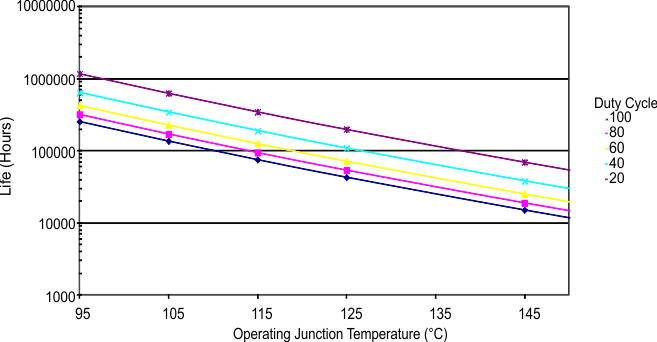
A. See data sheet for absolute maximum and minimum recommended operating conditions.
B. Product operating life design goal is >15 years for 65°C ≤ TJ ≤ 95°C based on silicon technology characterization per MIL-PRF-38535.
C. The predicted operating lifetime versus junction temperature is based on reliability modeling using electromigration as the dominant failure mechanism affecting device wearout for the specific device process and design characteristics.
Figure 1. 6-A Continuous Current Estimated Device Life
7.7 Typical Characteristics
